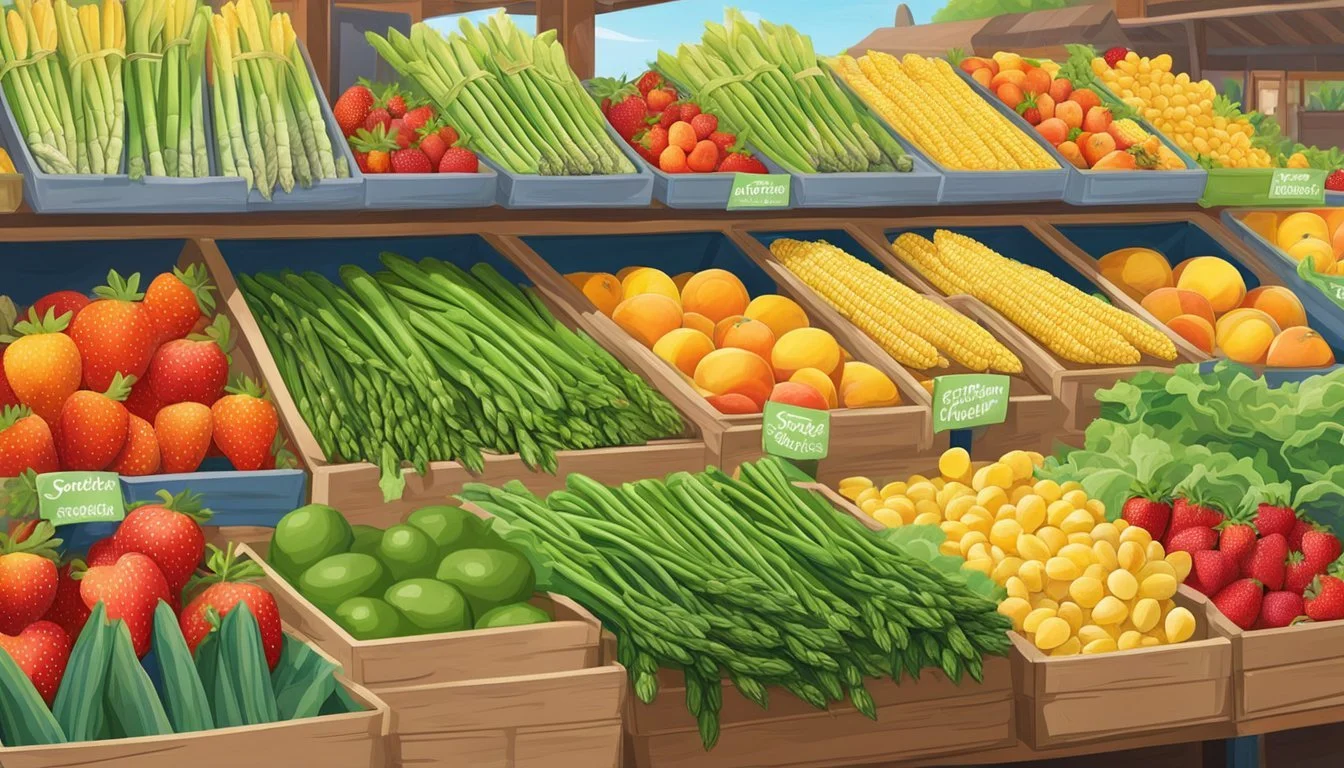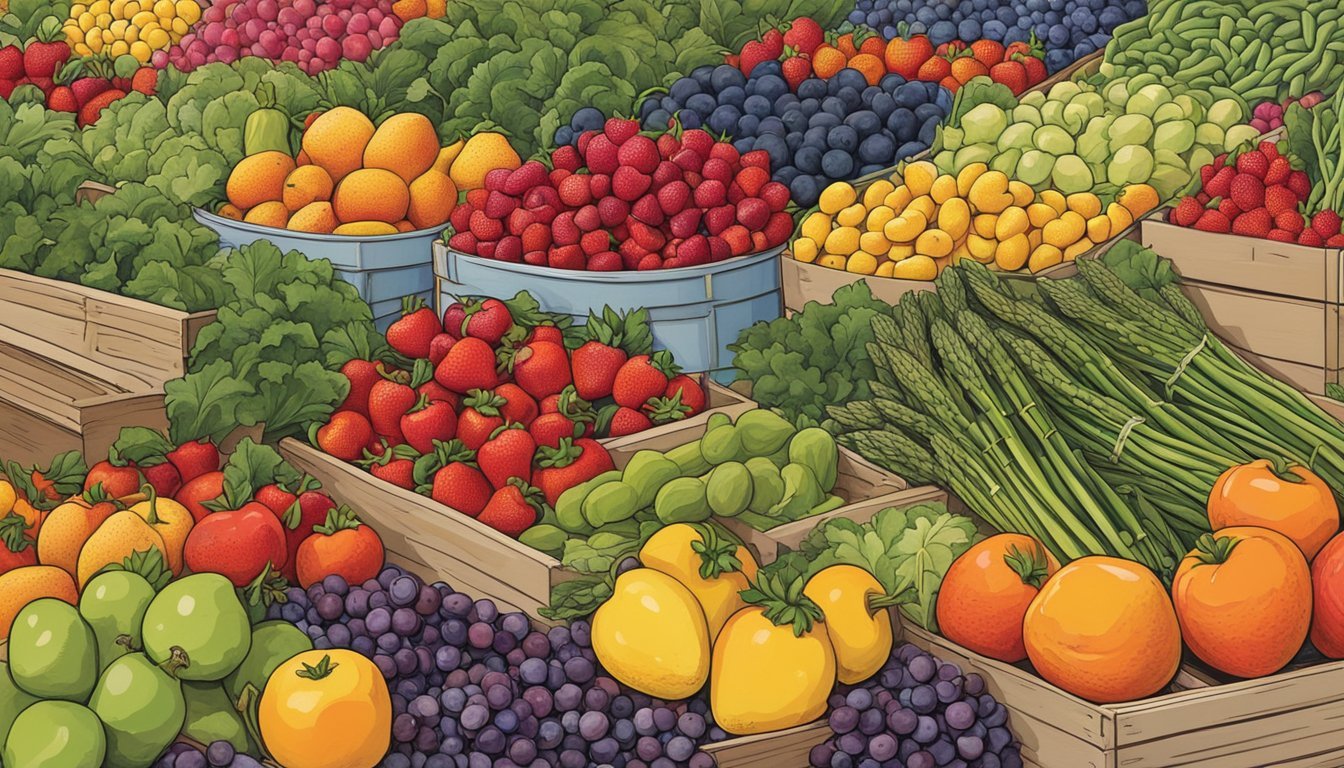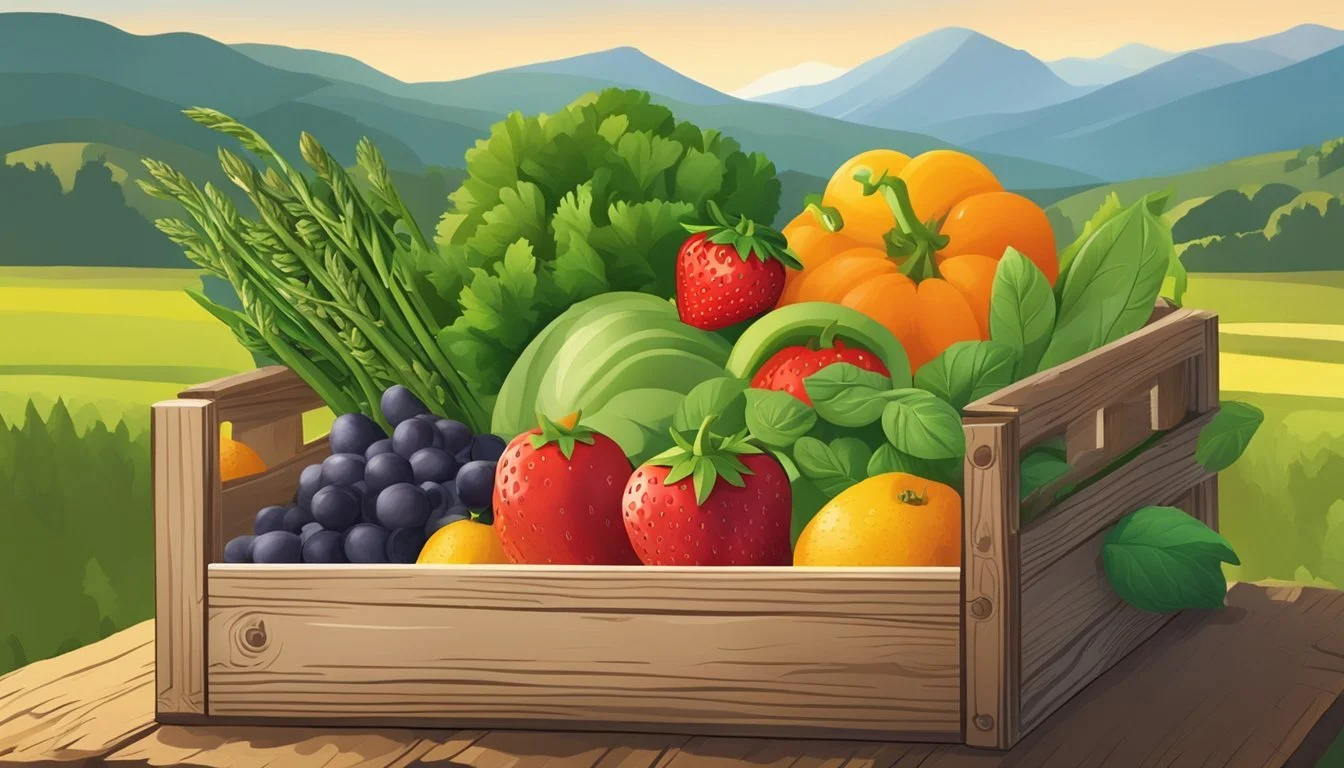Colorado Seasonal Fruit & Vegetables in April
Your Fresh Guide
This Article is Part of our Colorado Seasonal Fruit & Veg Calendar
In Colorado, April marks a transitional period where the last vestiges of winter begin to give way to the onset of spring. This shift is reflected in the seasonal produce that starts to become available. Consumers seeking freshness can anticipate a range of fruits and vegetables that are best consumed during this month. Embracing seasonal eating not only ensures peak flavor and nutrition but also supports local agriculture and sustainability efforts.
During this time, Coloradans can enjoy the hardy offerings from winter, such as the storage crops including carrots and potatoes, which tend to last through early spring. Simultaneously, early spring vegetables start to make their appearance. Nutrient-dense greens like spinach and the robust flavors of green garlic, radishes, and scallions begin to flourish, offering fresh and vibrant options for seasonal cuisine.
As April progresses, the state’s agricultural backdrop becomes more diverse. Specialties such as asparagus (how long does asparagus last?) spearhead the arrival of spring, while the tail-end of winter crops like the versatile winter squash wrap up their season. Colorado’s unique climate and varied elevation contribute to the availability and timing of these crops, ensuring that there's always a variety of fresh and locally grown produce to enjoy.
The Benefits of Seasonal Eating
Eating fruits and vegetables in their peak season can lead to better taste and higher nutritional content while benefiting the environment and local economy.
Nutritional Value
Seasonal produce often contains optimal levels of vitamins and minerals. Fruits and vegetables, when harvested in their prime season, ensure the highest nutritional quality. For example, morels and nettles, which are in season in April in Colorado, are not only fresh but packed with nutrients. Morels provide a good source of vitamin D and B vitamins, while nettles are rich in vitamins A, C, and K.
Environmental Impact
Choosing seasonal produce can greatly reduce the carbon footprint associated with long-distance transportation. Fresh, locally-sourced fruits and vegetables do not require extensive shipping, which significantly cuts down on greenhouse gas emissions. Additionally, seasonal farming practices often align closely with sustainable agriculture, promoting biodiversity and soil health.
Economic Advantages
Purchasing in-season produce supports local farmers and the regional economy. Consumers benefit financially as the abundance of fresh, seasonal crops typically leads to lower prices. When individuals buy in-season items, they contribute to the economic sustainability of farming communities by ensuring a consistent demand for their harvests.
Colorado's Climate and Agriculture
In the state of Colorado, the relationship between the local climate and agricultural practices is both complex and dynamic, particularly in the month of April when the growing season commences.
Geographical Influence
Colorado's farming regions are profoundly affected by the state's topography. The geography ranges from plains in the east to mountains in the center and plateaus in the west. Altitude varies significantly, and as a result, so does the climate. For agriculture, this means a wide range of growing conditions. The Eastern Plains tend to have a more forgiving climate for farming, while the Rocky Mountains present a challenging environment with a shorter growing season.
Seasonal Weather Patterns
In April, Colorado's weather begins to transition from winter to spring. Temperatures can be variable, with a possibility of warm days followed by cold nights. Despite this volatility, the month signifies a critical time for planting certain crops. Farmers must be attentive to frost dates, as a sudden spring frost can damage sprouting plants. Colorado's seasonal weather in April typically demands a strategic approach to agriculture to maximize the potential yield within the varied climate zones.
Guide to April's Seasonal Produce
April in Colorado heralds the arrival of spring, bringing a variety of fresh produce to the state. This guide provides a focused look at the vegetables and fruits that are in season during this month, allowing Coloradans and visitors to select the freshest ingredients for their meals.
Vegetables Available in April
In April, Colorado's soil becomes abundant with a range of vegetables, particularly greens and root vegetables. Shoppers can expect to find:
Greens: Arugula, Spinach
Root Vegetables: Radishes, Carrots (from storage)
Herbs: Chives, Parsley
Consumers will also delight in the arrival of tender Asparagus spears, a true sign of spring.
Fruits Available in April
April is more limited in terms of locally-grown fruit options, as many fruit crops are not yet in season. However, those looking for Colorado-grown fruits might still enjoy:
Last season's Apples and Pears from cold storage.
Patrons eager for the taste of Colorado-grown fruits may need to wait until the warmer months, as the state's famed peaches, melons, and berries come into season later in the year.
Storing and Preparing Colorado's April Produce
In April, Colorado's harvest brings an array of produce that requires proper storage and preparation to ensure maximum freshness and flavor. Knowing the right techniques can make the seasonal bounty last longer and taste better.
Storage Tips
Morels: Store these wild mushrooms in a paper bag in the refrigerator to allow air circulation; they can last up to a week.
Nettles: Refrigerate nettles in a plastic bag for up to a week. They should be handled with gloves to avoid stinging until blanched.
Asparagus: Keep asparagus fresh by trimming the ends and standing them upright in a jar with an inch of water, covered loosely with a plastic bag.
Spinach, Salad Greens, and Other Leafy Vegetables: Store these in a plastic bag in the crisper drawer with a paper towel to absorb excess moisture.
Radishes: Remove the tops and store radishes in a plastic bag in the refrigerator; they'll stay crisp for about a week.
Rhubarb: Wrap rhubarb stalks in plastic wrap or a damp towel, and refrigerate to maintain crispness.
Preparation Ideas
Morels: Morels need to be cleaned thoroughly since they can harbor tiny insects and debris. Soak briefly in water with a pinch of salt, then rinse and pat dry before cooking.
Nettles: Nettles should be blanched to remove the sting, then they can be used like spinach. They're excellent in soups, as a cooked green, or in pesto.
Asparagus: Snap off woody ends before cooking. Asparagus can be roasted, grilled, steamed or blanched and works well with light seasonings.
Spinach, Salad Greens, and Other Leafy Vegetables: Rinse leafy vegetables carefully to remove dirt. Spinach can be sautéed, while other greens are perfect for salads or wilting into dishes.
Radishes: These can be eaten raw for a crunchy texture in salads or roasted for a milder, softer outcome.
Rhubarb: Only the stalks are edible and should be cooked before eating. Rhubarb can be stewed or used in baking desserts like pies and crumbles.
Where to Find Colorado's Seasonal Produce
Access to fresh produce in Colorado peaks in April as springtime begins to usher in a new cycle of growth. Consumers seeking the freshest fruits and vegetables have a variety of options at their disposal.
Farmers' Markets
Farmers' markets provide a thriving venue for seasonal produce directly from local farms. These markets are seasonal hubs where consumers can find a broad array of fruits and vegetables. They support local economies and offer the opportunity to engage with growers. Key markets include the Boulder Farmers Market and Denver Union Station Farmers Market, which showcase Colorado's springtime offerings.
Community Supported Agriculture (CSA)
Community Supported Agriculture programs allow consumers to purchase a share of a farm's harvest. In April, CSA members can start to receive a range of fresh, locally-grown produce periodically throughout the growing season. CSA is a means to support local farms directly while ensuring a regular supply of fresh items.
Local Groceries
Local grocery stores often stock Colorado-grown produce, focusing on seasonal and locally sourced items when available. These may include items like fresh greens which start to come into season in April. Stores typically advertise their local sourcing with signs and labels, often under the Colorado Proud logo, to indicate products' state origin.
Cooking with Colorado's Fresh April Produce
In April, Colorado's fresh produce includes a variety of items like morels, nettles, spinach, asparagus, and rhubarb, which can inspire an array of seasonal recipes and pairing suggestions ideal for the home cook.
Seasonal Recipes
Morel Mushroom Risotto (What wine goes well with mushroom risotto?): Utilize the earthy flavors of fresh morels by incorporating them into a creamy risotto, a perfect dish for the still-chilly April evenings.
Nettle Soup: Nettles, high in nutrients, can be cooked into a vibrant green soup that is both comforting and refreshing.
Spinach Salad with Asparagus: Combine fresh spinach leaves with lightly blanched asparagus, top with a lemon vinaigrette, and garnish with shaved Parmesan for a crisp, fresh salad.
Rhubarb Crisp: As a simple dessert, chop rhubarb into pieces, sweeten with sugar and a touch of orange zest, and cover with a crunchy oat topping before baking until golden brown.
Pairing Suggestions
Morels and Red Wine: Try pairing sautéed morels with a glass of medium-bodied red wine, like a Pinot Noir, to bring out the mushrooms' deep, earthy taste.
Nettles and Hard Cheese: After blanching nettles, one might serve them with a hard cheese such as Pecorino, allowing its saltiness to contrast the mild green flavor.
Spinach and Eggs: Fresh April spinach pairs well with eggs, whether in a quiche (What wine goes well with quiche?) with a flaky crust or a fresh spinach and goat cheese omelet.
Rhubarb and Custard: The tartness of rhubarb is excellently balanced by the richness of vanilla custard, a classic combination for a springtime dessert.
April Gardening Tips for Colorado
April in Colorado presents a mix of unpredictable weather patterns and the promise of longer days—ideal for gardeners to commence their planting efforts. Emphasis is on the careful selection of crops and protective measures against the state's infamous late spring frosts.
What to Plant in April
In April, Colorado gardeners should focus on sowing seeds that thrive in cool-season conditions:
Leafy Greens: Such as kale, lettuce, Swiss chard, spinach, and arugula. These greens can be planted in various settings:
Vegetable gardens
Raised beds
Patio containers
Herbs: Parsley and chives are hearty choices. Gardening experts recommend sowing these seeds densely, as they grow well in close proximity without thinning.
Cool-Season Vegetables: Include:
Broccoli
Cauliflower
Cabbage
Brussels sprouts
Kohlrabi
Onions
Additionally, root vegetables like carrots and radishes, and peas with supportive trellises, can be directly sowed into the garden.
For optimal germination, maintaining soil moisture is crucial, especially for newly planted seeds and seedlings.
Protection from Late Frosts
Colorado's April gardeners must not overlook the likelihood of late frosts, which can endanger tender plants:
Monitoring: Keep an eye on local weather forecasts to anticipate frost.
Covering: Utilize frost cloths or blankets to shield vulnerable plants during cold nights.
Placement: Strategic garden planning involves placing sensitive crops in locations that are less prone to frost, such as near the house or under the canopy of trees.
Remember to remove covers during the day to allow for sunlight exposure and to prevent overheating if daytime temperatures rise significantly.
Understanding the Seasonal Produce Calendar
In Colorado, the growing season influences not only when crops are planted but also their peak availability for consumers. In April, one can expect the transition of produce availability from spring to summer varieties.
Spring and Summer Seasons
Spring in Colorado marks the beginning of the growing season for many fruits and vegetables. Early spring offerings generally include:
Morels (April through June)
Nettles (April through June)
As temperatures rise, these early spring crops are joined by summer produce which includes fruits and vegetables that typically prefer warmer weather to mature.
Transitioning to Fall Produce
Throughout Summer, the diversity of available produce increases as more fruits and vegetables reach their optimal harvest time. However, as summer wanes, the produce calendar begins its transition into fall. Plants that withstand cooler temperatures start to take precedence in the harvest schedule. These typically include root vegetables and hardy greens that can endure the chillier nights. By understanding this shift, consumers can anticipate the availability of various produce as Colorado moves into the fall season.
Supporting Local Agriculture
Local agriculture in Colorado is a cornerstone of the state's economy, with community involvement and advancements in farming practices highlighted as essential factors for its success.
Community Involvement
In Colorado, the community's support for local farmers and producers is evident. They actively participate in community-supported agriculture (CSA) programs and frequent farmers markets, where they can purchase seasonal produce directly from the source. This direct support bolsters the local economy and ensures the viability of agricultural operations. The Colorado produce calendar indicates that specific crops like carrots are available from storage until April, encouraging consumers to buy these local items during this time.
The Future of Farming in Colorado
Looking ahead, farming in Colorado continues to evolve, with an emphasis on sustainability and local production. Research indicates strong public support for the state's agriculture, acknowledging its importance for Colorado's future economic well-being. Innovations and adaptive practices are becoming increasingly significant, particularly as Colorado faces climatic challenges like low humidity and variable temperatures that can impact growing seasons. The future of farming in Colorado hinges on the continued embrace of local agriculture by the community and the state's ability to adapt to changing environmental conditions.










